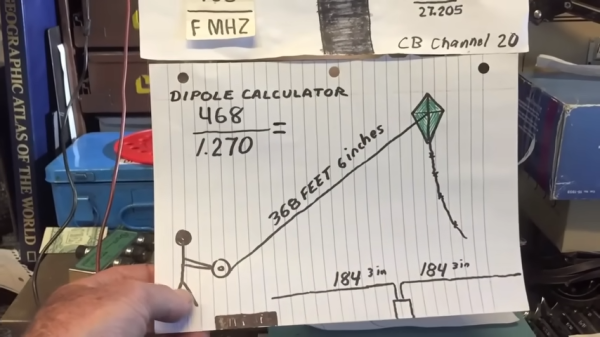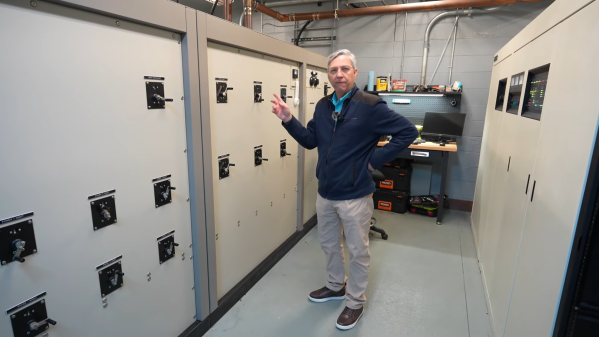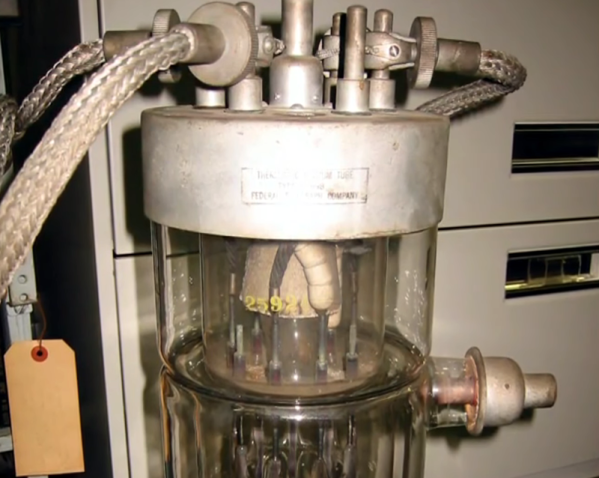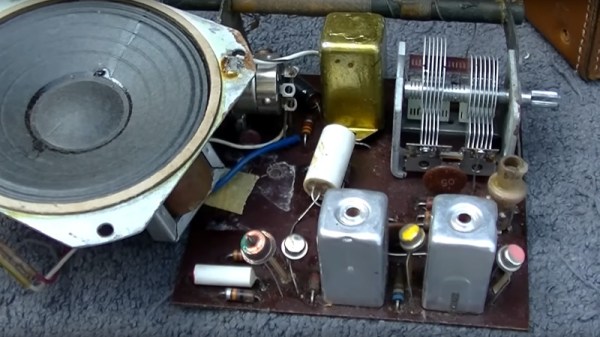We’ve been going on at length in this space about the death spiral that AM radio seems to be in, particularly in the automotive setting. Car makers have begun the process of phasing AM out of their infotainment systems, ostensibly due to its essential incompatibility with the electronics in newer vehicles, especially EVs. That argument always seemed a little specious to us, since the US has an entire bureaucracy dedicated to making sure everyone works and plays well with each other on the electromagnetic spectrum. The effort to drop AM resulted in pushback from US lawmakers, who threatened legislation to ensure every vehicle has the ability to receive AM broadcasts, on the grounds of its utility in a crisis and that we’ve spent billions ensuring that 80% of the population is within range of an AM station.
am radio29 Articles
Radio Frequency Burns, Flying A Kite, And You
Most hams can tell you that it’s possible to get a nasty RF burn if you accidentally touch an antenna while it’s transmitting. However, you can also cop a nasty surprise on the receiving end if you’re not careful, as explained in a video from [Grants Pass TV Repair].
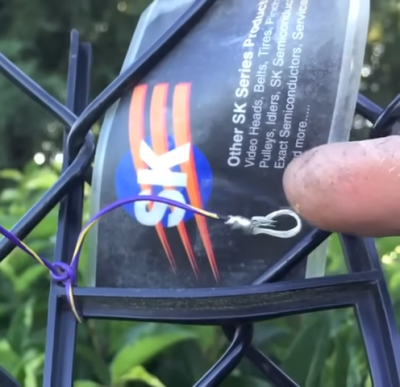
An experiment was used to demonstrate this fact involving a kite and a local AM broadcaster. A simple calculation revealed that an antenna 368 feet and 6 inches long would be resonant with the KAJO Radio signal at 1.270 MHz. At half the signal’s wavelength, an antenna that long would capture plenty of energy from the nearby broadcast antenna.
Enter the kite, which served as a skyhook to loft an antenna that long. With the wire in the air picking up a strong signal from the AM radio tower, it was possible to get a noticable RF burn simply by touching the end of the antenna.
The video explains that this is a risky experiment, but not only because of the risk of RF burn itself. It’s also easy to accidentally get a kite tangled in power lines, or to see it struck by lightning, both of which would create far greater injuries than the mild RF burn seen in the video. In any case, even if you know what you’re doing, you have to be careful when you’re going out of your way to do something dangerous in the first place.
AM radio towers aren’t to be messed with; they’ve got big power flowing. Video after the break.
Continue reading “Radio Frequency Burns, Flying A Kite, And You”
AM Radio Broadcast Uses Phasor To Let Eight Towers Spray One Big Signal
If you’re in the commercial AM radio business, you want to send your signal as far and wide as possible. More listeners means you can make more ad revenue, after all. [Jeff Geerling] recently visited a tower site for WSDZ-AM, which uses a full eight towers to broadcast its 20kW AM signal. To do that, it needs a phasor to keep everything in tune. Or, uh… phase.
The phasor uses a bunch of variable inductors and capacitors to manage the phase of the signal fed to each tower. Basically, by varying the phase of the AM signal going to each of the 8 transmitter towers, it’s possible to tune the directionality of the tower array. This allows the station to ensure it’s only broadcasting to the area it’s legally licensed to do so.
The tower array is also configured to broadcast slightly differently during the day and at night to account for the differences in propagation that occur. A certain subset of the 8 towers are used for the day propagation pattern, while a different subset is used to shape the pattern for the night shift. AM signals can go far farther at night, so it’s important for stations to vary their output to avoid swamping neighbouring stations when the sun goes down.
[Jeff’s] video is a great tour of a working AM broadcast transmitter. If you’ve ever wondered about the hardware running your local commercial station, this is the insight you’re looking for. AM radio may be old-school, but it continues to fascinate us to this day. Video after the break.
Continue reading “AM Radio Broadcast Uses Phasor To Let Eight Towers Spray One Big Signal”
How To Operate A 500KW Transmitter
Crosley was a famous name in radio for more than one reason. The National VOA Museum of Broadcasting has a video telling [Powel Crosley Jr.’s] story, and the story behind the 500 kW WLW transmitter. WLW was an AM broadcast station often called the nation’s channel since its signal covered most of the United States. The first Crosley station was identified at 8CR, running 20 watts from [Crosley’s] living room. Quite a modest start! By 1922, he had moved to his family business location along with 500 watts of output. Over the years, WLW got more powerful until it was finally a 500 kW giant.
Hackaday Links: August 27, 2023
We mentioned last week how robotaxi provider Cruise was having a no-good, very bad week, after one of their driverless taxis picked a fight with a semi, and it was revealed that amorous San Franciscans were taking advantage of the privacy afforded by not having a driver in the front seat. It appears that we weren’t the only ones to notice all the bad news, since California’s Department of Motor Vehicles issued an order to the company to cut its robotaxi fleet in half. The regulatory move comes after a recent Cruise collision with a fire truck, which injured a passenger in the taxi. Curiously, the DMV order stipulates that Cruise can only operate 50 vehicles during the day, while allowing 150 vehicles at night. We’d have thought the opposite would make more sense, since driving at night is generally more difficult than during daylight hours. But perhaps the logic is that the streets are less crowded at night, whereas daytime is a more target-rich environment.
A Vintage Transistor Radio Gets A Repair
Here in 2023 the field of electronics covers a breathtaking variety of devices and applications, but if we were to go back in time far enough we’d enter an age in which computers were few and far between, and any automated control systems would have been electromechanical at best. Back in the 1950s the semiconductor industry was in relative infancy, and at the consumer end electronics were largely synonymous with radio. [Shango066] brings us a transistor radio from that era, a Jewel TR1 from about 1958, that despite its four-transistor simplicity to our eyes would have been a rare and expensive device when new.
As you’d expect, a transistor radio heading toward its 70th birthday requires a little care to return to its former glory, and while this one is very quiet it does at least work after a fashion. The video below the break is a long one that you might wish to watch at double speed, but it takes us through the now-rare skill of fault-finding and aligning an AM radio receiver. First up are a set of very tired electrolytic capacitors whose replacement restores the volume, and then it’s clear from the lack of stations that the set has a problem at the RF end. We’re treated to the full process of aligning a superhet receiver through the relatively forgiving low-frequency medium of a medium-wave radio. Along the way, he damages one of the IF transformers and has to replace it with a modern equivalent, which we would have concealed under the can from the original.
The video may be long, but it’s worth a look for the vintage parts if not for the quality of radio stations on the air today in California. For many readers, AM broadcast is becoming a thing of the past, so we’re not sure we’ll see this very often.
Hackaday Links: May 28, 2023
The Great Automotive AM Radio War of 2023 rages on, with the news this week that Ford has capitulated, at least for now. You’ll recall that the opening salvo came when the US automaker declared that AM radio was unusable in their EV offerings thanks to interference generated by the motor controller. Rather than fixing the root problem, Ford decided to delete the AM option from their EV infotainment systems, while letting their rolling EMI generators just keep blasting out interference for everyone to enjoy. Lawmakers began rattling their sabers in response, threatening legislation to include AM radio in every vehicle as a matter of public safety. Ford saw the writing on the wall and reversed course, saying that AM is back for at least the 2024 model year, and that vehicles already delivered without it will get a fix via software update.


